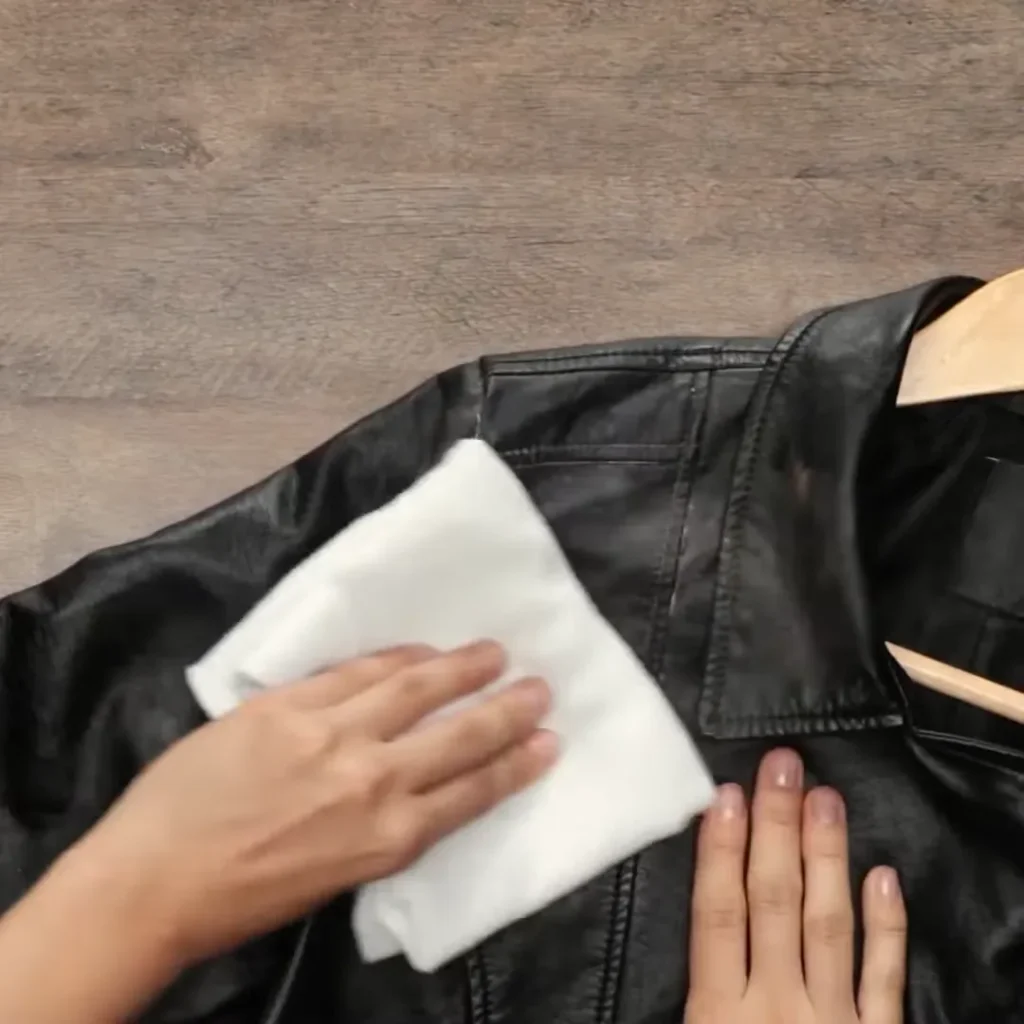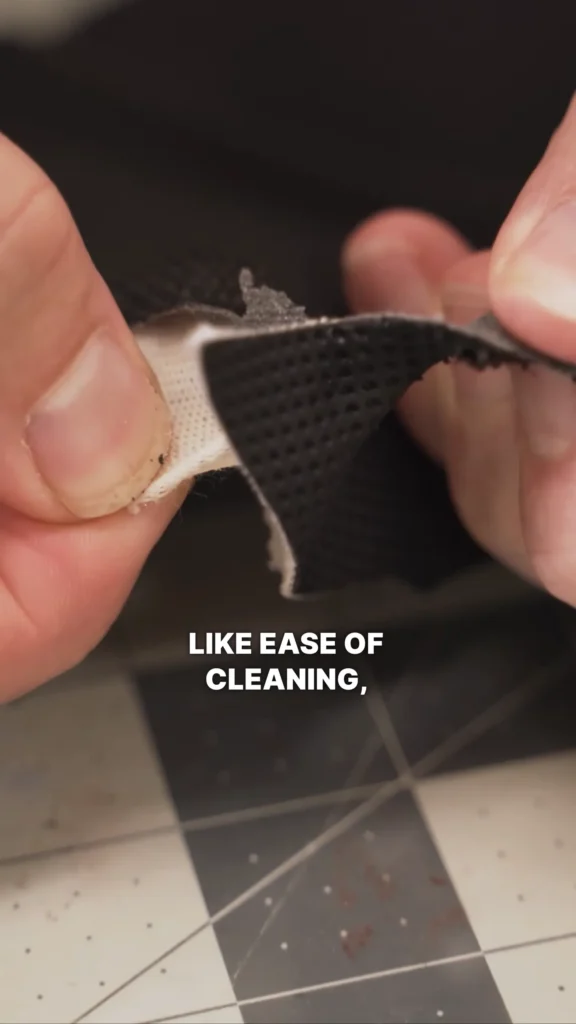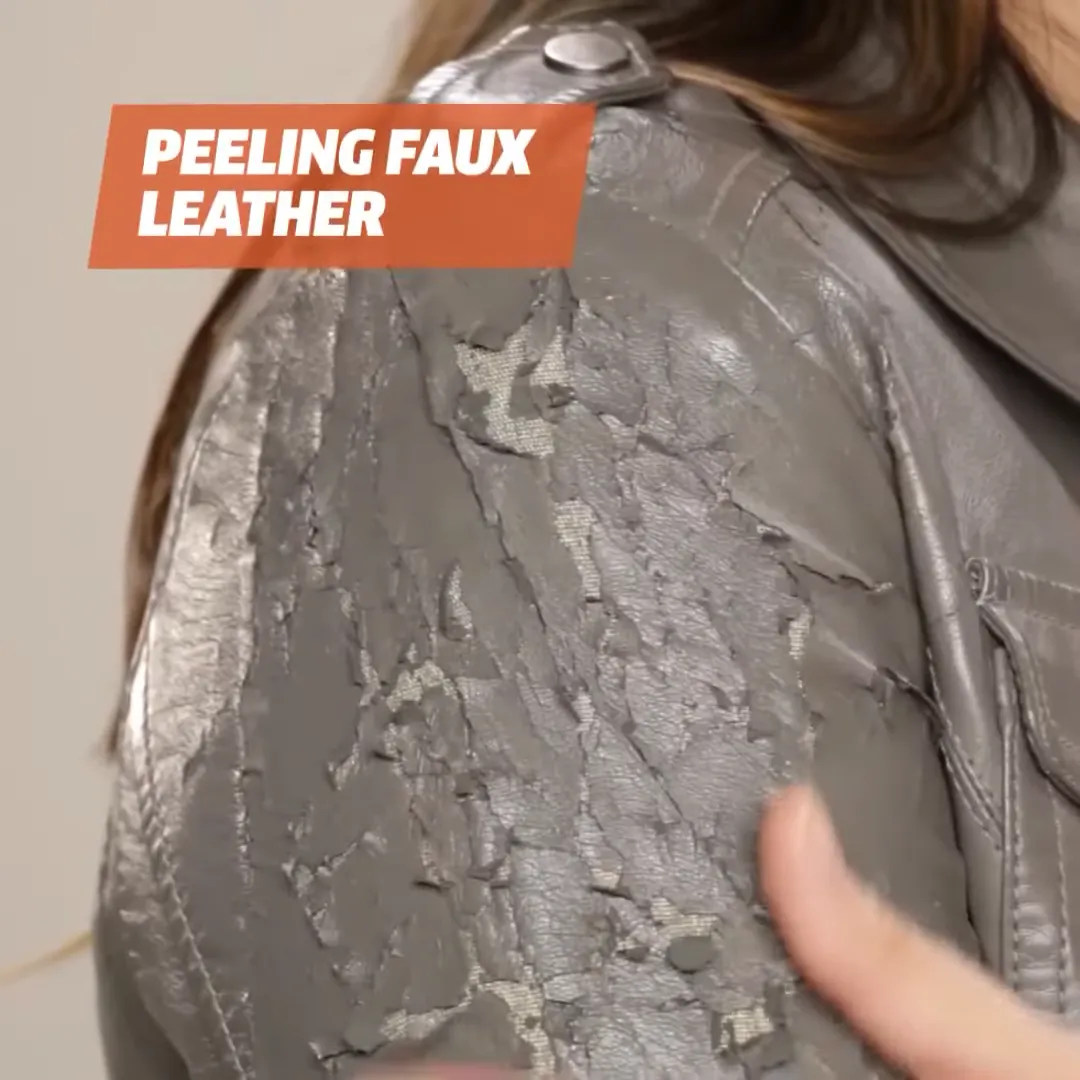Faux leather, a popular alternative to genuine leather, presents a stylish yet ethical choice for fashion enthusiasts. Its unique composition, mimicking the look and feel of real leather, has garnered widespread appeal in various fashion domains. However, questions often arise about its suitability in different weather conditions, particularly in the rain.
Faux leather can indeed be worn in the rain, although with some considerations. Its synthetic materials generally offer good resistance to water, making it a practical option for damp weather. However, prolonged exposure to heavy rain may affect its appearance and durability over time.
Faux leather’s viability in rainy weather is not just about its water resistance; it’s also about understanding its maintenance and care. While it holds up well against light showers, it requires proper care to maintain its aesthetic appeal. This characteristic makes it a versatile material, capable of enduring diverse weather conditions with the right handling.
## Brief Overview of Faux Leather
Faux leather, also known as synthetic or artificial leather, has emerged as a popular alternative in the fashion and upholstery industries. It mimics the texture and appearance of real leather but is made from different materials. Its development stems from the desire to create a product that resembles leather in look and feel, without using animal hides. This innovation caters to ethical concerns and offers a cost-effective solution compared to genuine leather.
The appeal of faux leather extends beyond its ethical and financial benefits. It’s available in various colors and textures, allowing designers to experiment with styles that might be difficult to achieve with real leather. Its versatility makes it a favorite in creating a wide range of products, from jackets and shoes to furniture and car interiors.
## Importance of Understanding Material Suitability in Weather Conditions
Selecting the right material for specific weather conditions is crucial, especially when it comes to items like clothing and accessories that are exposed to various elements. Understanding the suitability of materials like faux leather in different weather scenarios is not just about maintaining their appearance but also about functionality and longevity. This knowledge is essential for consumers who wish to make informed choices and for designers who aim to create durable and practical products.
## Faux Leather Composition
### What is Faux Leather Made Of?
Faux leather is primarily made from polyvinyl chloride (PVC) or polyurethane (PU). These synthetic materials are applied to a base layer, often made of polyester, to create a texture similar to that of genuine leather. The manufacturing process involves treating the base material with wax, dye, or polyurethane to achieve the desired color and texture.
### Comparing Faux Leather with Genuine Leather
While genuine leather is made from animal hides, faux leather offers a synthetic alternative. Here are key differences:
– **Source**: Genuine leather comes from animal hides, while faux leather is made from synthetic materials.
– **Texture and Appearance**: While high-quality faux leather can closely mimic the look of genuine leather, it often lacks the unique characteristics and patina that develop over time with natural leather.
– **Durability**: Genuine leather is generally more durable and can last for decades if properly maintained, whereas faux leather may show wear and tear more quickly.
– **Maintenance**: Faux leather is easier to clean and doesn’t require the conditioning that genuine leather does.
– **Cost**: Faux leather is typically more affordable than genuine leather.
– **Environmental Impact**: The production of genuine leather has a significant environmental footprint, whereas the production of faux leather, especially newer eco-friendly varieties, can be less impactful.
## Weather Resistance of Faux Leather
### Faux Leather and Water Interaction
Faux leather’s reaction to water is a key aspect of its weather resistance. While not inherently waterproof, most types of faux leather have a good level of water resistance. This means they can handle light rain and splashes without absorbing moisture like genuine leather. However, extended exposure to water can lead to damage over time.
### Protective Qualities in Various Weather Conditions
Faux leather’s synthetic composition gives it certain advantages in diverse weather conditions:
– **Light Rain**: It can resist light rain and dry faster than genuine leather.
– **Extreme Temperatures**: In very hot or cold conditions, faux leather may crack or peel if not properly maintained.
– **Sun Exposure**: Prolonged exposure to the sun can cause fading and weakening of the material.
## Pros and Cons of Wearing Faux Leather in Rain

### Advantages of Choosing Faux Leather
1. **Water Resistance**: Faux leather’s ability to repel water makes it suitable for light rainy conditions.
2. **Ease of Maintenance**: It can be easily wiped dry and doesn’t require extensive care post-exposure to rain.
3. **Fashion Versatility**: Available in various styles, faux leather remains fashionable even in wet weather.
### Potential Drawbacks in Wet Conditions
1. **Limited Breathability**: Faux leather doesn’t breathe as well as genuine leather, which can be uncomfortable in humid conditions.
2. **Durability Concerns**: Repeated exposure to heavy rain can lead to quicker degradation of the material.
3. **Environmental Concerns**: Certain types of faux leather can release harmful chemicals when exposed to water over time.
In conclusion, faux leather presents a viable option for those seeking a stylish yet practical material that can withstand light to moderate rain. Its synthetic nature offers both advantages and limitations, making it essential for consumers to weigh these factors based on their specific needs and environmental conditions. As the demand for sustainable and ethical fashion alternatives grows, understanding the properties and care requirements of materials like faux leather becomes increasingly important.
## Maintaining Faux Leather in Rainy Weather
When it comes to maintaining faux leather, especially in rainy weather, a proactive approach is key. This synthetic material, while resilient in many ways, requires certain care practices to ensure its longevity and appearance are preserved.
### Essential Care Tips for Faux Leather
1. **Prompt Drying**: After exposure to rain, it’s crucial to dry faux leather items promptly. Gently pat them down with a soft, dry cloth to remove excess moisture. Avoid using heat sources like hairdryers, as they can warp or crack the material.
2. **Regular Cleaning**: Regular cleaning is vital for maintaining faux leather’s appearance. Use a mild soap and water solution, wiping the surface with a soft cloth. For tougher stains, a specialized faux leather cleaner is recommended.
3. **Protection Measures**: Apply a protective spray or conditioner designed for synthetic leather. These products help repel water and protect against stains, making them ideal for rainy weather conditions.
4. **Avoid Prolonged Wetness**: Try not to let your faux leather items stay wet for extended periods. This can lead to deterioration of the material, including cracking or peeling.
### Longevity and Durability Concerns
The durability of faux leather in rainy weather largely depends on the quality of the material and the care it receives. High-quality faux leather, combined with proper maintenance, can withstand rainy conditions quite well. However, constant exposure to heavy rain and neglect in care can significantly reduce its lifespan.
## Fashion and Practicality
### Styling Faux Leather for Rainy Days
Faux leather’s sleek and stylish appearance makes it a fashionable choice even on rainy days. Here are some tips for styling it:
– **Layering**: Pair a faux leather jacket with a waterproof coat. This not only protects the faux leather but also adds a trendy layered look.
– **Accessories**: Opt for faux leather accessories, like bags and shoes, which can add a chic touch to any rainy-day outfit.
– **Color Choices**: Darker colors like black or navy are more forgiving of rain spots and blend seamlessly with rainy-day attire.
### Versatility of Faux Leather in Fashion
Faux leather’s versatility extends beyond just weather resistance; it also offers a range of stylistic options. It can be dressed up for formal occasions or styled casually for everyday wear. The material’s ability to imitate various leather textures and colors adds to its adaptability in fashion.
What happens if faux leather gets wet?
When faux leather gets wet, several reactions can occur, depending on the duration and intensity of the exposure to water:
1. **Water Resistance**: Faux leather is usually water-resistant, meaning it can handle small amounts of water, such as light rain or spills, without being damaged immediately. This resistance is due to its synthetic coating, which provides a certain level of protection against moisture.
2. **Surface Changes**: If faux leather remains wet for a prolonged period or is repeatedly exposed to water, the surface might begin to show wear and tear. This could manifest as a change in texture, color fading, or a decrease in its characteristic sheen.
3. **Risk of Peeling or Cracking**: Prolonged exposure to water can lead to the faux leather peeling or cracking. This happens because the synthetic materials in faux leather, like PVC or polyurethane, can break down over time, especially when they’re not allowed to dry properly. This breakdown affects the material’s flexibility and structural integrity.
4. **Mildew and Odor**: If faux leather is not dried thoroughly after getting wet, it can develop a musty odor or mildew. This is especially true in humid conditions where the material doesn’t dry out completely, leading to the growth of mold and mildew.
5. **Stiffening of Material**: In some cases, getting wet and then drying can cause faux leather to stiffen. This change in texture can affect both the appearance and the comfort of faux leather items.
To minimize these issues, it’s important to dry faux leather gently and thoroughly after it gets wet and to condition it periodically to maintain its flexibility and appearance.
## Alternatives to Faux Leather in Rain
### Other Rain-Appropriate Materials
While faux leather is a good option, there are other materials suited for rainy weather:
– **Nylon and Polyester**: These synthetic fabrics are inherently water-resistant and dry quickly.
– **Waxed Cotton**: Offers a classic look and excellent water resistance, ideal for coats and jackets.
– **Rubber**: Perfect for footwear, providing full waterproof protection.
### Comparing Durability and Style

In terms of durability and style, each material has its pros and cons:
– **Faux Leather**: Stylish and versatile, but requires careful maintenance in rainy weather.
– **Nylon/Polyester**: Highly durable and low-maintenance but may lack the aesthetic appeal of faux leather.
– **Waxed Cotton**: Offers a timeless style but can feel heavier and less flexible.
– **Rubber**: Excellent for wet conditions, though often limited in style and comfort for extended wear.
## Expert Opinions
Gleaning insights from fashion and material experts offers valuable perspectives on the practicality and styling of faux leather, particularly in rainy conditions. These insights not only inform consumers but also guide designers and manufacturers in their material choices and product designs.
### Insights from Fashion and Material Experts
Fashion experts often emphasize the versatility of faux leather, highlighting its ability to adapt to various styles and climates. They note its growing popularity in ethical fashion circles, where it’s prized for being a cruelty-free alternative to genuine leather. Material experts, on the other hand, focus on the technical aspects. They point out that while faux leather’s synthetic composition offers water resistance, it does require specific care to maintain its integrity and appearance over time, especially when exposed to rain frequently.
### Real-Life Experiences and Recommendations
Many users of faux leather apparel and accessories report satisfaction with its performance in light to moderate rain. However, they also caution against exposure to heavy downpours without adequate protection, like waterproof sprays. Recommendations often include regular maintenance, such as gentle cleaning and conditioning, to ensure the material remains supple and crack-free.
## Frequently Asked Questions
Addressing common queries can help clarify doubts and provide practical advice for those considering or currently using faux leather products.
### Addressing Common Queries About Faux Leather
– **Can Faux Leather Dry Out After Getting Wet?**
Faux leather can dry out and crack if not properly cared for after getting wet. It’s important to gently wipe off excess water and let it air dry.
– **Does Faux Leather Smell After Rain?**
Sometimes, faux leather can develop a mildew-like smell if not dried properly. Keeping it in a well-ventilated area after getting wet helps prevent this issue.
– **Can I Machine Wash Faux Leather?**
It is generally not advisable to machine wash faux leather, as the agitation and heat can damage the material. Spot cleaning is the recommended method.
### Debunking Myths and Providing Facts
One common myth is that faux leather is completely waterproof, which is not entirely true. While it offers good resistance to water, it’s not impervious to prolonged exposure to rain. Understanding this distinction is crucial for proper care and usage.
## Recap of Key Points
Reflecting on the key points discussed, it becomes clear that while faux leather is a viable option for use in rainy conditions, it does come with certain caveats. Its synthetic nature provides a degree of water resistance, but this does not equate to full waterproofness. Appropriate care, including regular cleaning and the application of protective treatments, is essential to maintain its appearance and durability.
### Final Thoughts on Faux Leather in Rainy Conditions
In the evolving world of fashion and materials, faux leather stands out as a notable choice for those seeking a balance between style, practicality, and ethical considerations. Its ability to withstand light to moderate rain, coupled with the right maintenance routine, makes it a functional and fashionable option. However, understanding its limitations and care requirements is key to ensuring its longevity and preserving its aesthetic qualities. As the industry continues to innovate and consumers become more informed, the role of materials like faux leather in fashion will undoubtedly continue to grow and evolve.
### Frequently Asked Questions2
#### Can Faux Leather Get Ruined in the Rain?
No, faux leather does not get ruined in light rain. Its synthetic material is typically water-resistant, making it suitable for mild wet conditions. However, continuous exposure to heavy rain can lead to damage over time, such as cracking or peeling.
#### How Do I Protect Faux Leather from Rain?
To protect faux leather in the rain, consider using waterproofing sprays or protective conditioners. These products help create an additional layer of protection against moisture. Also, after exposure to rain, gently wiping the surface dry can prevent water spots and maintain its appearance.
#### Is Faux Leather Waterproof?
Faux leather is water-resistant to a degree but not entirely waterproof. It can withstand light rain and splashes but may not hold up well in prolonged or heavy rainfall. For complete water protection, additional waterproofing treatments are recommended.
#### How Long Does Faux Leather Last in Rainy Conditions?
The longevity of faux leather in rainy conditions depends on the frequency of exposure and the level of care. With proper maintenance and occasional waterproofing treatments, it can last for several years, even in climates with frequent rain.
### Conclusion
Faux leather offers a practical and stylish choice for those looking to navigate fashion in rainy weather. While it showcases commendable resistance to light showers, its durability in heavier rain relies on proper care and occasional treatments. Its versatility, coupled with ethical considerations, makes it a preferred choice for many.
In conclusion, wearing faux leather in the rain is feasible, with the caveat of mindful maintenance. Its adaptability in various weather conditions, balanced with the need for care, positions it as a viable material for fashion-conscious individuals. This adaptability, combined with ethical production methods, positions faux leather as an enduring choice in the realm of sustainable fashion.




